Gholaia (Bu Njem)
Q61197614Gholaia: Roman fort, part of the Limes Tripolitanus, modern Bu Njem.
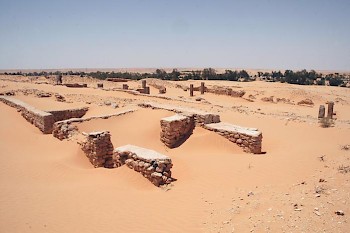
There are many reasons to visit the ruins of ancient Gholaia or, as it is called today, Bu Njem. Admittedly, the remains don't look impressive when you approach them for the first time, but they belong to the most impressive monument of Libya: the Roman frontier zone, or limes. The emperor Septimius Severus (193-211) ordered the construction of a line of fortifications, which completely changed this part of Libya, Tripolitana.

Today, this is desert, but the area is not as arid as it seems. In fact, there is sufficient rainfall, but it is highly unpredictable and irregular. However, when the wadis have dams and dikes, the water can be regulated, and the area can be developed for agricultural purposes. This is what happened in the early third century. The first stage was to build forts like Gholaia. This map shows that it was a stereotypical castellum with barracks, a bathhouse, headquarters and a residence for the commander.
Other forts were at Ghadames and Gheriat al-Garbia. They were built by soldiers of the Third Legion Augusta. This can be deduced from the towers near the main gate, which are not square, as is usual, but five-angled. This can only be found in settlements of the Third, which was based in Lambaesis in what is now Algeria. Gates like this can also be seen in Theveste.

The new forts controlled the main roads through the desert, and were situated near oases. On this photo of Gholaia's eastern gate, you can see the Bu Njem oasis in the background. It is about 100 km from the coast. By blocking access to the wells, the forts protected the country that was to be developed against large groups of nomads (e.g., the Garamantes, who lived beyond the Gebel as-Soda). Against small bands, however, guarding the wells offered insufficient protection, so the farms that were to be built, had to have strong walls to keep invaders out for some time. Examples can be found at Gheriat esh-Shergia, Ghirza, and Qasr Banat. There were also watchtowers that signaled the arrival of intruders. The Limes Tripolitanus was a fine system, and many people settled in Tripolitana as farmers, producing sufficient to make sure that towns like Sabratha, Oea (modern Tripoli), and Lepcis Magna prospered. Many settlers must have been veterans from the three forts.
Their culture, based on expert water management and vigilance, survived the Roman Empire. Of course, there were changes. In the late fifth, early sixth century, there were serious troubles, but the emperor Justinian reinforced the cities along the coast, built new towns (e.g., Theodorias) and the fortified farms were strengthened. An example is Suq al-Awty, which contains a small Byzantine church.
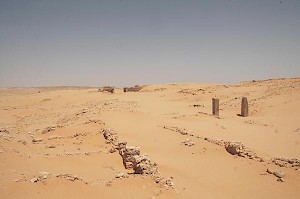
In the seventh century, the population converted to Islam and the Tripolitanan limes culture survived well into the eleventh century, when war between the Fatimid and Zirid dynasties resulted in invasions by the Banu Hillal nomads, who sacked countless settlements. Because many farms were abandoned, agricultural production fell, and the towns along the coast went into decline.
As a result, there were less people who could loot the abandoned forts and farms. (Oea is the exception.) The stones were never reused and were covered by desert sands. The settlements were forgotten until Italian archaeologists started to investigate them in the1920s and 1930s.

The foundations of the Principia have survived reasonably well. Several columns surrounding the square court have been reerected by the French and Libyan archaeologists who studied the site in the 1970s. The quad may have been used as a market place, because no other site can been identified. There must have been a small prison too; its existence is implied in Ostracon #71. (The ostraca from Bu Njem are sherds on which reports and letters were written. Some of them were discovered in the room you can see in front. A little to the rear is the only scriptorium that has been identified in a Roman fort.)
The Principia (HQs) must have looked like the principia elsewhere; these buildings were the same all over the empire. Gholaia also had a square court surrounded by small rooms, a large transverse hall (basilica), and a shrine (sacellum) were the unit's standard was kept and venerated. If the graffito shown below is reliable, the sacellum was pretty high. The unit's library must have been in one of the adjoining rooms.
The soldiers who served at Gholaia were recruited from all over Africa, like most legionaries of III Augusta. However, in 219, the emperor Heliogabalus disbanded the Third Legion Gallica, and many soldiers of this unit were added to the African legion. This means that several soldiers in Gholaia were from Syria.
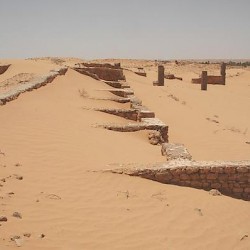 Principia |
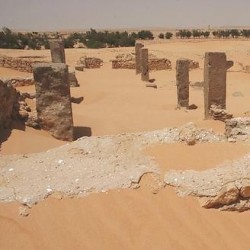 Principia |
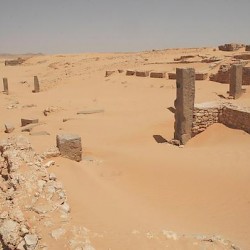 Principia, Sacellum |
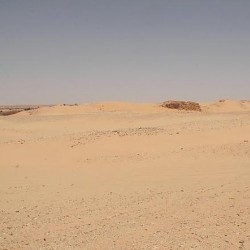 Bu Njem, Desert |
 Principia |
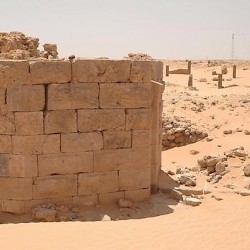 East Gate, southern tower |
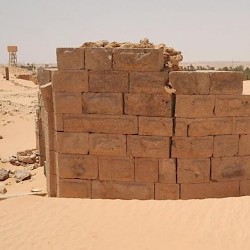 East Gate, northern tower |
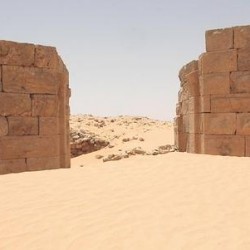 East Gate |